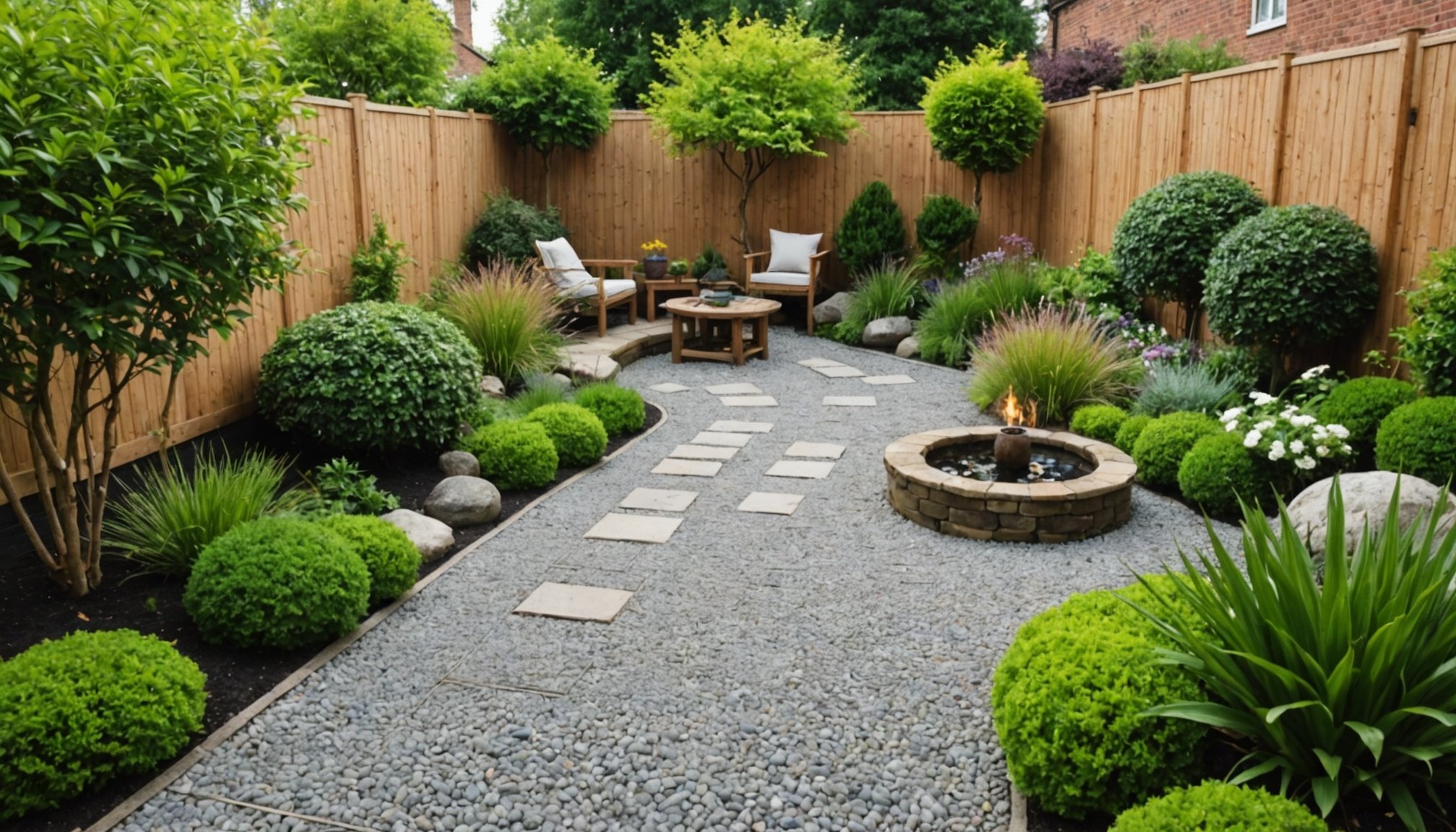Urban living can feel chaotic, but your small UK backyard can become a calming escape. Imagine transforming it into a tranquil Zen garden, where minimalism meets nature. This guide offers a step-by-step process to create a serene space suitable for reflection and relaxation. From choosing the right plants to incorporating soothing elements, you'll discover how achievable serenity can be, even in the heart of the city. Let’s embark on this journey to cultivate your personal oasis.
Understanding Zen Gardens
Zen gardens, also known as Japanese rock gardens, are serene spaces designed to promote tranquility and reflection. Originating in Japan during the Muromachi period, these gardens are traditionally composed of sand, rocks, and carefully placed elements to mimic natural landscapes. The principles of Zen design emphasize simplicity, balance, and harmony, which are crucial in creating a peaceful environment.
A lire en complément : Transform Your UK Semi-Detached Home with Solar Roofs: Aesthetic Solutions for Seamless Installation
One of the key principles in Zen garden design is asymmetry, which encourages a natural, uncontrived appearance. Additionally, Zen gardens often incorporate the concept of 'Ma,' or negative space, which allows for contemplation and mental clarity. The use of minimal plant life and the careful arrangement of stones and sand patterns further enhance the garden's tranquil atmosphere.
In an urban gardening context, creating a Zen garden can offer numerous benefits. These gardens provide a tranquil escape from the bustling city life, allowing individuals to unwind and connect with nature. Even in small spaces, Zen gardens can be adapted to fit balconies or rooftops, making them accessible to urban dwellers. By incorporating the principles of Zen design, urban gardening enthusiasts can cultivate a peaceful retreat that fosters relaxation and mindfulness amidst the chaos of city living.
A lire aussi : Maximizing Space: Creative Ways to House a Large Family in a Three-Bedroom UK Home Without an Extension
Assessing Your Space
Before creating a Zen garden in a small urban backyard, it is essential to conduct a thorough space evaluation. This involves understanding the dimensions and characteristics of your area to make the most of the available space.
Start by measuring and mapping your backyard. Accurately measuring the length and width helps you visualize potential layouts for your Zen garden. Use graph paper or digital tools to create a scaled map, which will assist in planning the placement of rocks, sand, and other elements.
Next, identify sunlight patterns and microclimates. Observe how sunlight moves across your backyard throughout the day. This information is crucial for deciding where to place features that may require more or less sunlight. Additionally, note any areas that are consistently shaded or exposed to wind, as these microclimates can affect plant growth and the overall ambiance of your garden.
Finally, recognize existing features and limitations. Take into account any permanent structures, such as walls or fences, as well as the condition of the soil. Understanding these factors will help you adapt your Zen garden design to the unique aspects of your space, ensuring a harmonious and functional retreat.
Design Inspiration and Ideas
Exploring various Zen garden design styles can offer a wealth of inspiration for your urban retreat. Traditional Zen gardens often feature a minimalist approach, focusing on elements like sand and stones to evoke natural landscapes. However, modern interpretations can incorporate additional elements to suit diverse tastes and spaces.
Consider integrating water features into your Zen garden. A small fountain or pond can enhance the garden's serene ambiance, offering the soothing sound of running water. Water features can be adapted to fit any size, making them ideal for small urban spaces.
Stones play a crucial role in Zen garden design. Use them to create focal points or define pathways. Carefully arranged stones can symbolize mountains or islands, adding depth and interest to your garden layout.
Utilizing vertical space is another effective strategy, especially in compact areas. Vertical gardens or trellises can introduce greenery without occupying valuable ground space. Additionally, pathways can guide visitors through the garden, creating a sense of journey and discovery.
Whether you prefer a traditional or contemporary style, drawing inspiration from various Zen garden designs can help you craft a unique and tranquil space that reflects your personal aesthetic and the principles of Zen.
Choosing the Right Plants
Selecting the appropriate plants for your Zen garden is crucial, especially when considering the UK climate. The variability in weather conditions requires choosing vegetation that can withstand both wet and dry periods. Opt for hardy species that thrive in temperate climates, ensuring they can survive seasonal changes.
Recommended Zen Garden Plants
Incorporate plants that embody the Zen garden aesthetic. Japanese maples, with their delicate leaves and vibrant autumn hues, add seasonal interest and visual appeal. Bamboo can provide vertical structure and a sense of enclosure, while moss offers a soft, carpet-like texture that enhances the tranquil atmosphere.
Tips for Incorporating Seasonal Interest
To maintain year-round appeal, select a mix of evergreen and deciduous plants. Evergreen species like dwarf pines or junipers retain their foliage throughout winter, providing structure and greenery even in colder months. Deciduous plants, such as cherry blossoms, can introduce bursts of colour and interest during spring and summer.
Consider the following tips for a successful planting scheme:
- Choose a variety of plants with different textures and colours.
- Group plants with similar water and light needs together.
- Allow space for growth to avoid overcrowding as plants mature.
By carefully choosing plants suited to the UK climate, your Zen garden will remain vibrant and harmonious all year round.
Hardscaping Elements
Incorporating hardscaping into your Zen garden can enhance its structure and aesthetic. Selecting the right materials for pathways and borders is crucial. Opt for natural materials like gravel, stones, or wood, which harmonize with the garden's serene atmosphere. These materials not only define spaces but also contribute to the overall design elements.
When choosing materials, consider durability and appearance. Gravel paths offer a rustic charm and are easy to maintain. Stone pathways, on the other hand, provide a more robust and timeless look. Wooden borders can add warmth and contrast, creating a seamless blend between the garden and its surroundings.
Integrating natural elements such as wood and stone helps to create a harmonious balance. Stones can act as focal points or anchors, while wood can introduce organic textures. This balance is essential in maintaining the garden's tranquility and ensuring that the hardscaping complements, rather than overwhelms, the natural elements.
To achieve a cohesive design, ensure that the hardscaping materials align with the garden's overall theme. By thoughtfully selecting and arranging these elements, you can craft a Zen garden that offers both visual appeal and a peaceful retreat.
Creating Focal Points
In Zen garden design, focal points are essential to guide the eye and enhance the garden's tranquil atmosphere. These design elements serve as visual anchors, creating a sense of balance and harmony. By thoughtfully incorporating focal points, you can elevate the aesthetic appeal of your garden and foster a deeper sense of peace.
Ideas for Focal Points
Consider integrating garden features such as sculptures, lanterns, and water features. Sculptures can add artistic flair and cultural significance, while traditional stone lanterns provide a timeless and serene glow. Water features, like a small pond or a bubbling fountain, introduce soothing sounds and reflections, enhancing the garden's tranquility.
Positioning for Impact
To maximise the impact of focal points, position them strategically within the garden. Place them at the end of pathways or in open spaces to draw attention and invite contemplation. Ensure that these features are proportionate to the surrounding elements to maintain a harmonious balance. By carefully selecting and positioning focal points, you can create a Zen garden that not only captivates the senses but also offers a serene escape from the everyday hustle.
Maintenance and Upkeep
Maintaining a Zen garden requires regular attention to preserve its tranquility and beauty. Essential garden maintenance tasks include raking sand patterns to keep them crisp and defined, as well as cleaning and repositioning stones to maintain balance and harmony. Regular pruning of plants ensures they remain healthy and in proportion with the garden's design.
Seasonal Care
Seasonal care is crucial for the garden's longevity. In spring, focus on refreshing sand and gravel areas, and inspect hardscaping for any winter damage. Summer requires vigilant watering, especially for new plantings. Autumn is ideal for mulching and preparing the garden for colder months. During winter, protect sensitive plants with coverings and clear pathways of debris.
Managing Weeds and Pests
Managing weeds and pests is a challenge in urban environments. Regularly inspect your garden for invasive plants and remove them promptly to prevent spread. Use natural deterrents like neem oil or diatomaceous earth to combat pests without harming the environment. Maintaining a clean and tidy garden reduces habitats for pests, ensuring your Zen garden remains a peaceful retreat amidst urban chaos.
Overcoming Urban Challenges
Urban gardening presents unique challenges, especially when creating a Zen garden in limited spaces. Urban gardening challenges often stem from restricted areas and environmental factors that require creative solutions and adaptability.
One common challenge is the limited space available in urban settings. To address this, consider vertical gardening techniques, such as using trellises or wall-mounted planters, to maximize space. This approach not only saves ground area but also adds layers and depth to your Zen garden.
Another issue is the lack of natural light in densely built environments. To overcome this, choose shade-tolerant plants and position them strategically to make the best use of available sunlight. Reflective surfaces, like water features or light-coloured stones, can also enhance the garden's brightness.
Adapting Zen principles to urban settings involves embracing simplicity and balance in design. Focus on creating a harmonious layout with minimal elements, ensuring each component has a purpose and contributes to the garden's tranquility. By prioritizing adaptable solutions and maintaining a flexible approach, you can transform even the smallest urban space into a serene Zen garden, providing a peaceful retreat amidst the city's hustle and bustle.
Budget-Friendly Options
Creating a Zen garden doesn't have to break the bank. With some budget gardening strategies, you can design a tranquil retreat using cost-effective solutions and DIY ideas.
Affordable Materials and Plants
Start by choosing materials that are both affordable and aesthetically pleasing. Gravel and sand are inexpensive options for creating the classic Zen garden look. For plants, opt for hardy perennials that require little maintenance, such as ferns or hostas. These plants not only thrive in various conditions but also add lush greenery without frequent replacements.
DIY Projects
Personalize your Zen garden with simple DIY projects. Constructing your own wooden benches or stone lanterns can add character and save money. Use recycled materials, like old bricks or pallets, to create pathways or borders. These projects not only reduce costs but also allow for creative expression.
Money-Saving Tips
To keep expenses low, consider sourcing materials locally or from garden centres during sales. Swap cuttings with friends or neighbours to expand your plant collection without spending. Planning and budgeting ahead ensures you allocate resources wisely, creating a peaceful environment that is both beautiful and affordable.
Visual Examples and Resources
Drawing inspiration from Zen garden examples can significantly enhance your design process. Observing successful small urban Zen gardens offers valuable insights into adapting traditional elements to compact spaces. These gardens often showcase innovative use of vertical space and minimalistic design, creating a serene retreat even in bustling urban environments.
Design Resources
To further fuel your visual inspiration, consider exploring various design resources. Online platforms such as Pinterest and Instagram feature a plethora of Zen garden images, demonstrating diverse styles and creative solutions. These resources can help you visualize how different elements come together to form a cohesive and tranquil space.
Recommended Books and Websites
For those seeking deeper knowledge, numerous books and websites offer comprehensive guidance on Zen garden design. Books like "Zen Gardens: The Complete Works of Shunmyo Masuno" provide detailed insights into the philosophy and techniques behind these gardens. Websites such as The Japanese Garden Society offer expert advice and community forums for enthusiasts to share ideas and experiences.
By leveraging these resources, you can gain a deeper understanding of Zen garden aesthetics and principles, enabling you to create a personalized and peaceful urban oasis.












